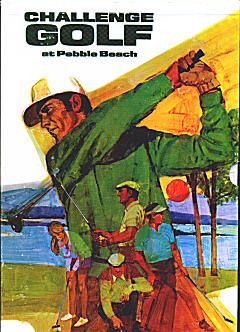
Challenge Golf at Pebble Beach
Par 72; 6,815 Yards
3M Company – 1972 – 1-4 Players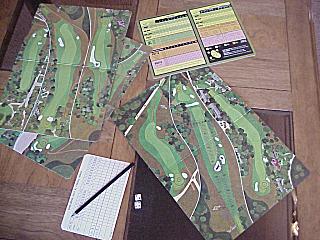 Challenge Golf is another board game representation of the game of golf. This one is set on a replica of the famous Pebble Beach Golf Course in California.
Challenge Golf is another board game representation of the game of golf. This one is set on a replica of the famous Pebble Beach Golf Course in California.
Play is quite simple. The course holes are printed on plastic coated boards and the location of the ball is noted by making a mark on the board with a special pencil. The player announces which club they are using and how far they want to hit the ball. (A chart gives the possible ranges for each club.) The player then takes the “Distance Finder”, a T-shaped piece of transparent plastic and place it on the board in the direction they wish the ball to travel with the ball location at the point corresponding to the distance they chose.
The player then rolls dice and consults the chart for the chosen club to see if they hit the ball short or long and adjust the Distance Finder accordingly. They then make a second roll to see if the ball went straight or drifted to the left or right. Finally, the effect of wind is factored in and the ball location noted on the board.
When the ball is on the green, a putting chart is consulted to determine the number of strokes necessary to complete the hole. Play continues through all 18 holes. There are several possible types of play, including both Match and Stroke play and Sides, Singles, Twosomes, Threesomes, Foursomes, Three-Ball and Best-Ball. The actual winning conditions vary slightly based on the type of game chosen but in general the lowest score wins (as in real golf).
There are a wide variety of special rules dealing with trees, sand traps, water hazards, hitting from the rough and so on.
One interesting aspect of the game is that the players select a specific golfer that they are playing. “Old Smoothy” ignores extreme die rolls, “Ironsides” is more accurate with irons, “Boomer” gets more distance with woods and “The Blade” is better at putting.
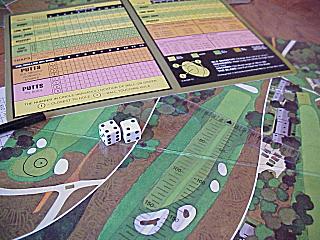 Challenge Golf has a split personality. It is a sports game but is packaged like part of the Bookshelf games. It uses a very similar system to that used in Thinking Man’s Golf with the main difference being the way in which shot distance is determined. Players familiar with Thinking Man’s Golf should have no problem with this game. The different golfers which can be played actually improve the system by creating some differentiation between the players and by adding an additional challenge in that the players must consider how to use each golfer’s special ability to their advantage. Another very good game in the 3M line.
Challenge Golf has a split personality. It is a sports game but is packaged like part of the Bookshelf games. It uses a very similar system to that used in Thinking Man’s Golf with the main difference being the way in which shot distance is determined. Players familiar with Thinking Man’s Golf should have no problem with this game. The different golfers which can be played actually improve the system by creating some differentiation between the players and by adding an additional challenge in that the players must consider how to use each golfer’s special ability to their advantage. Another very good game in the 3M line.
As an interesting note, Pebble Beach was the site of the 1972 US Open Golf Tournament (the same year this game was released) and the four golfers from the game match the characteristics of the top players from that tournament.
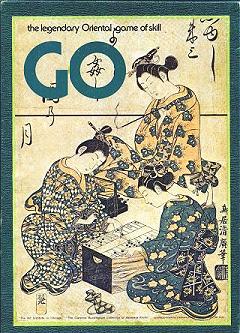
 Go is a game which originated in China over 4000 years ago. (The oldest known reference is from 2356 BC.) The game is played on a grid and the playing pieces (or “stones”) are placed on the intersections of the grid lines. Players alternate placing stones on the intersections. The object of the game is to surround the most territory with stones of your color.
Go is a game which originated in China over 4000 years ago. (The oldest known reference is from 2356 BC.) The game is played on a grid and the playing pieces (or “stones”) are placed on the intersections of the grid lines. Players alternate placing stones on the intersections. The object of the game is to surround the most territory with stones of your color. Go is an amazingly deep game. It looks simple; the rules are much simpler than those of chess for example. Don’t be fooled. Any game which has lasted for more than 4000 years is not something that can be mastered overnight. A very complex game that can take years to learn how to play well.
Go is an amazingly deep game. It looks simple; the rules are much simpler than those of chess for example. Don’t be fooled. Any game which has lasted for more than 4000 years is not something that can be mastered overnight. A very complex game that can take years to learn how to play well.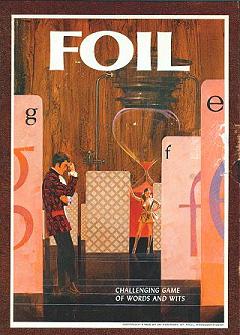
 Foil is a word game. Players are dealt cards, each of which has a letter on it. Without showing their cards to the other players each player attempts to form their cards into as many words as possible. Each player, in turn, draws additional cards and discards cards until one player is able to form all of the cards in their hand into words. The players then scramble the cards they were able to use and place them in their racks. The players then have five minutes to determine what words the other players have formed. The players score points for forming words, for determining what the other player’s words are and for forming additional words from the other player’s cards that the other players missed. After three rounds the player with the highest score is the winner.
Foil is a word game. Players are dealt cards, each of which has a letter on it. Without showing their cards to the other players each player attempts to form their cards into as many words as possible. Each player, in turn, draws additional cards and discards cards until one player is able to form all of the cards in their hand into words. The players then scramble the cards they were able to use and place them in their racks. The players then have five minutes to determine what words the other players have formed. The players score points for forming words, for determining what the other player’s words are and for forming additional words from the other player’s cards that the other players missed. After three rounds the player with the highest score is the winner.
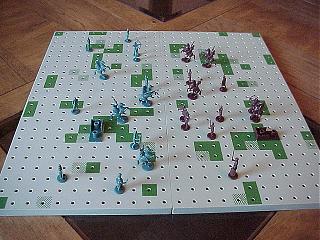 Feudal is a variant on chess. Like chess, the players maneuver pieces in an attempt to capture their opponent’s. Feudal replaces the pieces from chess with the King, Prince, Duke, Knights, Sergeants, Pikemen, Squires and Archers. Also as in Chess, each piece has a particular manner in which it is allowed to move.
Feudal is a variant on chess. Like chess, the players maneuver pieces in an attempt to capture their opponent’s. Feudal replaces the pieces from chess with the King, Prince, Duke, Knights, Sergeants, Pikemen, Squires and Archers. Also as in Chess, each piece has a particular manner in which it is allowed to move.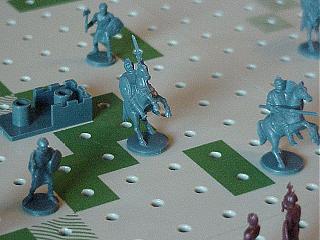 Feudal is an attempt to create a version of chess which plays more like a war game. It falls somewhere into the middle ground which I think would cause it to lose most of its audience. The game is still too abstract to attract many avid war gamers and the variations are unlikely to appeal to hardcore chess players. Still the game can be fun, the pieces are very nice and there are provisions for up to six players. A fun game for a change of pace.
Feudal is an attempt to create a version of chess which plays more like a war game. It falls somewhere into the middle ground which I think would cause it to lose most of its audience. The game is still too abstract to attract many avid war gamers and the variations are unlikely to appeal to hardcore chess players. Still the game can be fun, the pieces are very nice and there are provisions for up to six players. A fun game for a change of pace.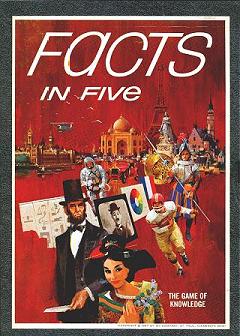
 Facts in Five is a trivia game. Five cards are drawn. Each card contains a “class” (such as “Living Celebrated Persons” or “Product Trade names”) and a list of “categories” (for the examples above some categories are American, Foreign, Male or Female and Soap, Candy, Wine or Beer). A category is selected for each class and the players note the five classes/categories on their score pads. Then, five letter tiles are drawn and the players note the letters on their pads as well.
Facts in Five is a trivia game. Five cards are drawn. Each card contains a “class” (such as “Living Celebrated Persons” or “Product Trade names”) and a list of “categories” (for the examples above some categories are American, Foreign, Male or Female and Soap, Candy, Wine or Beer). A category is selected for each class and the players note the five classes/categories on their score pads. Then, five letter tiles are drawn and the players note the letters on their pads as well.
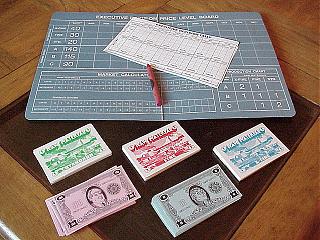 Executive Decision is another of the 3M company’s business simulation games. In it, the players represent the heads of large corporations. On each turn, the players make bids for quantities of “raw materials” (Standard, Fine and Extra Fine) and determine how many units of each “product” (A, B and C) they intend to produce. The price they pay for raw materials and the amount they receive for their products fluctuates according to rules of supply and demand. After a predetermined number of turns the game ends and the player who has made the most profit wins.
Executive Decision is another of the 3M company’s business simulation games. In it, the players represent the heads of large corporations. On each turn, the players make bids for quantities of “raw materials” (Standard, Fine and Extra Fine) and determine how many units of each “product” (A, B and C) they intend to produce. The price they pay for raw materials and the amount they receive for their products fluctuates according to rules of supply and demand. After a predetermined number of turns the game ends and the player who has made the most profit wins.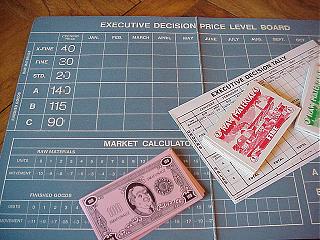 As a business simulation the game is quite abstract and simplified. Different products require different combinations of raw materials but the number of types of raw materials and possible products are limited. The only factor which affects price is supply and demand and the only influences there are the players themselves. No outside influences or competition exist. By leaving out the question of customer acceptance (for example) the game model is simplified but as any business knows it is possible to produce a product that no one wants to buy even with no competition. The game is a fairly interesting economic simulation as it is but the simplifications made make it less realistic than it would like you to believe.
As a business simulation the game is quite abstract and simplified. Different products require different combinations of raw materials but the number of types of raw materials and possible products are limited. The only factor which affects price is supply and demand and the only influences there are the players themselves. No outside influences or competition exist. By leaving out the question of customer acceptance (for example) the game model is simplified but as any business knows it is possible to produce a product that no one wants to buy even with no competition. The game is a fairly interesting economic simulation as it is but the simplifications made make it less realistic than it would like you to believe.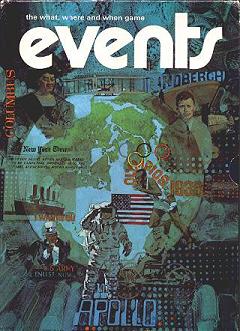
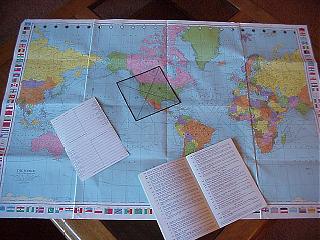 Events is a historical trivia game. One player is the “historian” and selects a specific event from history. The event can be something the historian knows about or it can be one of the 300 events in the included booklet (which range from the crowning of David as king of Israel in around 1000 BC to the withdrawal of US troops from Viet Nam in 1972 (remember, the game was published in 1974)). The historian then gives the other players “clues” about the event, starting with the general category of the Event (such as “Natural” or “Political”) and the general location of the event on the map using the “locale indicator”. (The game uses a world map as the game board.) The round then proceeds through 9 additional clues which alternate between allowing one player to ask one yes/no question and the historian giving out additional information such as the date, sub-category, specific location and the final “Telltale clue”.
Events is a historical trivia game. One player is the “historian” and selects a specific event from history. The event can be something the historian knows about or it can be one of the 300 events in the included booklet (which range from the crowning of David as king of Israel in around 1000 BC to the withdrawal of US troops from Viet Nam in 1972 (remember, the game was published in 1974)). The historian then gives the other players “clues” about the event, starting with the general category of the Event (such as “Natural” or “Political”) and the general location of the event on the map using the “locale indicator”. (The game uses a world map as the game board.) The round then proceeds through 9 additional clues which alternate between allowing one player to ask one yes/no question and the historian giving out additional information such as the date, sub-category, specific location and the final “Telltale clue”.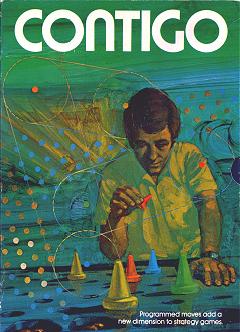
 Contigo is an alignment game for two players or a capture game for four players. The object of the two player game is for a player to get four pawns in a row (horizontally, vertically or diagonally) without any opposing pawns between them. The object of the capture game is to capture the key pawn of your opponents by landing on it with one of your own pawns.
Contigo is an alignment game for two players or a capture game for four players. The object of the two player game is for a player to get four pawns in a row (horizontally, vertically or diagonally) without any opposing pawns between them. The object of the capture game is to capture the key pawn of your opponents by landing on it with one of your own pawns.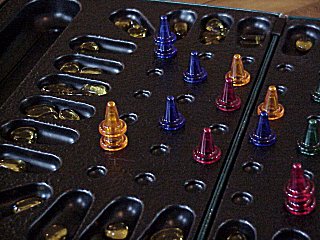 This is an interesting strategy game that combines both peg puzzles and mancala-style pit and pebble games into a single game. It is harder than it looks as players are really playing two games at once; trying to maneuver both their pawns and arrange pebbles. What happens is that a player starts concentrating too much on one half of the game and fails on the other half.
This is an interesting strategy game that combines both peg puzzles and mancala-style pit and pebble games into a single game. It is harder than it looks as players are really playing two games at once; trying to maneuver both their pawns and arrange pebbles. What happens is that a player starts concentrating too much on one half of the game and fails on the other half.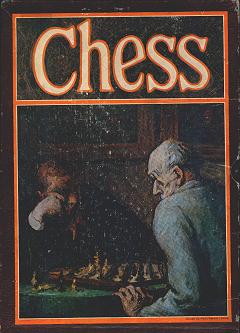
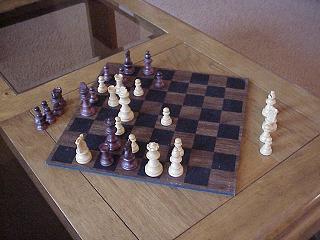 Chess is believed to have originated in India in around the year 600. From there it spread to Persia and onward to Europe. It is considered by many to be the origin of the modern war game.
Chess is believed to have originated in India in around the year 600. From there it spread to Persia and onward to Europe. It is considered by many to be the origin of the modern war game.

 Challenge Golf is another board game representation of the game of golf. This one is set on a replica of the famous Pebble Beach Golf Course in California.
Challenge Golf is another board game representation of the game of golf. This one is set on a replica of the famous Pebble Beach Golf Course in California. Challenge Golf has a split personality. It is a sports game but is packaged like part of the Bookshelf games. It uses a very similar system to that used in Thinking Man’s Golf with the main difference being the way in which shot distance is determined. Players familiar with Thinking Man’s Golf should have no problem with this game. The different golfers which can be played actually improve the system by creating some differentiation between the players and by adding an additional challenge in that the players must consider how to use each golfer’s special ability to their advantage. Another very good game in the 3M line.
Challenge Golf has a split personality. It is a sports game but is packaged like part of the Bookshelf games. It uses a very similar system to that used in Thinking Man’s Golf with the main difference being the way in which shot distance is determined. Players familiar with Thinking Man’s Golf should have no problem with this game. The different golfers which can be played actually improve the system by creating some differentiation between the players and by adding an additional challenge in that the players must consider how to use each golfer’s special ability to their advantage. Another very good game in the 3M line.